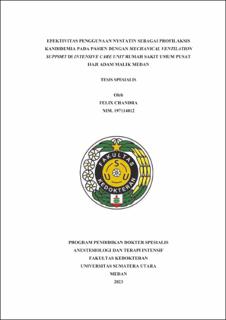| dc.description.abstract | Background: The Intensive Care Unit (ICU) is a treatment room that is susceptible to nosocomial
infections. Mechanical ventilation (MV) support is often required by 10-20% of patients admitted to the
ICU, where there is always a risk of candidemia. Candidemia is defined as a disease in any patient in a
health facility where Candida species are found to be isolated from blood culture specimens processed by
the laboratory. Candida species are one of the most common species causing bloodstream infection (BSI)
in non-neutropenic patients treated in the ICU and are responsible for 8-12% of cases. Antifungal
prophylaxis is often given in the ICU to patients who have the potential for candidemia using the Candida
Score, including: Candida colonization, history of surgery, severe sepsis, and receiving Total Parenteral
Nutrition (TPN). The use of nystatin is starting to be considered as a prophylactic antifungal in the ICU in
the hope of reducing the incidence of candidemia in the hope of reducing the morbidity and mortality of
patients in the ICU.
Objective: Analyzing the effectiveness of nystatin solution compared to 0.9% NaCl solution as
candidemia prophylaxis in critically ill patients in the ICU of Haji Adam Malik General Hospital Medan
Methods: The research design is randomized clinical trial with double blind method. After obtaining
approval from the Ethics Committee of the Faculty of Medicine, Universitas Sumatera Utara, Medan, 40
research samples were collected which, after meeting the inclusion criteria, were divided randomly into 2
groups. Group A received 100,000 IU/ml nystatin and group B received 0.9% Nacl. The research data
obtained were tested using SPSS.
Results: Positive blood culture results were fewer in the nystatin group compared to 0.9% NaCl (3 sv 4).
There were fewer positive tracheal aspirate culture results in the nystatin group compared to 0.9% NaCl
(0 vs 1). The largest distribution of Candida in blood culture was C. tropicalis, whereas in tracheal
aspirate culture only 1 species of C. glabrata was found. 7 day mortality appeared to be less in the nystatin
group compared to 0.9% NaCl (11 vs 14).
Conclusion: Nystatin is effective in reducing the incidence of candidemia. The incidence of candidemia
was less in the nystatin group compared to 0.9% NaCl. Tracheal aspirate culture results in the nystatin
group were better than 0.9% NaCl. Day 7 mortality in the nystatin group was less than in the 0.9% NaCl
group. The most distributed Candida species in culture was C. tropicalis, whereas in tracheal aspirate
culture only 1 species of Candida was found, namely C. glabrata. | en_US |





